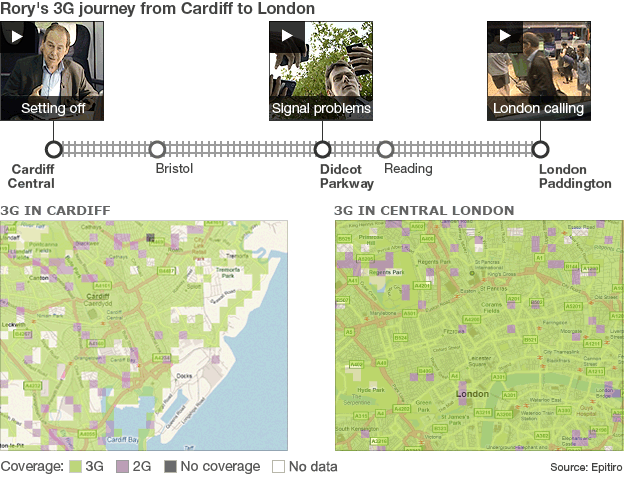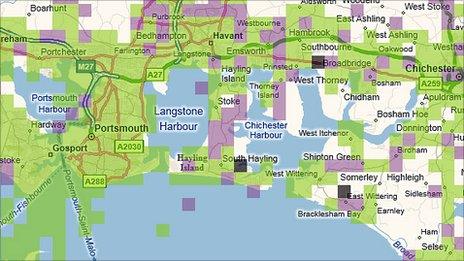BBC 3G mobile survey: Our conclusions
- Published
- comments
WATCH: Rory Cellan-Jones travels from Cardiff to London to find the "hot spots" and "not spots" in the mobile data network.
When we launched our 3G survey last month we could not be sure how much interest there would be.
I'm glad to say there was plenty - more than 44,000 people downloaded the Android app on all manner of devices, and data came in from the tip of Cornwall to the Shetland Islands.
The data shows that, overall, people are getting 3G about three quarters of the time, but coverage is nothing like as uniform as the picture painted in the coverage map issued by the mobile operators.
So most of a city will have excellent coverage but there will be certain places even quite near the centre where some if not all the networks are just not providing a data connection.
To prepare some radio and television reports about the survey results, I took a train from London to Cardiff and back - and gathered some of my own evidence. As ever, I travelled light - just three mobile phones, one mobile broadband MiFi unit, two tablet computers and a laptop.
Even on a train these days we've come to expect decent 3G coverage, and from London to Swindon, as I fiddled with my various devices on different networks, it looked as though it would be possible to get online pretty easily.

But as we headed further West and then into Wales, the periods where I got no signal - or no data signal at least - got longer and longer. Talking to various people who use that line a lot, I heard plenty of frustrations about the patchy coverage.
Filming in Cardiff the next day, we found a black spot, where the majority of our testers had failed to get a data signal in Roath, just a couple of miles from the city centre. Again, passers-by told us of their frustrations when using smartphones in the area.
On the way back from Cardiff, I hopped off the train at Didcot Parkway to meet one of the people who had downloaded the UK 3G survey app.
Chris Phillips is training to be a Church of England vicar at a college in the Oxfordshire village of Cuddesdon. He's also a devoted to his Android smartphone - though he's struggling to use many of its capabilities.
That's because the village - just a few miles from the M40 - appears to be among our 3G notspots. The bar chart in the 3G survey app on Chris's phone showed that he'd spent around two thirds of his time on 2G - the 3G bar probably reflects his journeys into Oxford for lectures.
When I asked him why on earth a trainee vicar needed 3G anyway, Chris answered with Christian forbearance: "In this day and age we need to keep in touch with the real world - just because we're training to serve the church it doesn't mean we don't need to know what's going on."
What struck me during this project was just how many people - from priest to plumbers to paediatricians - now see a mobile phone with a data connection as essential to their working lives.
We're not making huge claims for our mobile map - it is after all just a snapshot - but it may provide consumers and the mobile networks themselves with a better picture of the real state of coverage.
And ours is not the only source - a London-based startup called OpenSignalMaps, external has also been mapping 3G across the UK. They've kindly given us access to their data, collected from 30,000 users of their Android app. You can read more about their research here, external - but I've pulled out a couple of headlines.
They identified over 22,000 locations where no 3G signal was available - for the most part, as you'd expect, in rural areas. The highest concentration was in Gwynedd in North Wales, closely followed by Cumbria.
But in terms of the amount of time people are spending on 3G, they've got that at 58%, much lower than our 75%.
And their overall conclusion - like ours - is that while most of the big cities are well served by 3G, it can be a real challenge getting a decent connection elsewhere.
So, thanks to everyone who has made the effort to help chart the UK's mobile coverage. Let's hope the map will be useful not just to consumers, but to mobile operators trying to make sure that the notspots get ever smaller.
- Published24 August 2011



